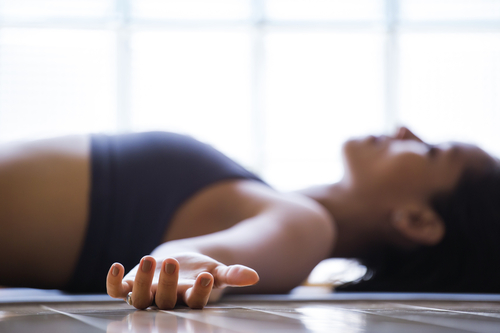Yoga Nidra is an ancient meditation technique. An astonishing, accessible and totally effortless meditation journey that anyone can practice, by ourselves, in a class, or by using audio recordings. Yoga Nidra is usually done lying down and does not involve physical movement. It promotes deep healing and profound rest at every level of being: energetic, mental, emotional, and intuitive.
Yoga Nidra works systematically through each aspect of our human being. First establishing deep physical rest and balance at a biochemical level, which enables the systems of the body (which are often out of sync or disturbed) to move towards optimal balance and cyclical functioning.
Once the opening stages of Yoga Nidra enable our bodies to rest and function optimally, then we are able to restore vitality and emotional stability.
The combination of deep physical rest, vitalization and the settling of thoughts and emotions improves health and productivity, heightens intelligence and creativity, and gives deeper intuition, wisdom and insight.
Yoga Nidra is effective in the relief of insomnia, depression, panic attacks, and other stress-related problems, and it also helps the management of chronic pain and as a tool for self-examination.
There is evidence from colleagues around the world for the efficacy of Yoga Nidra in relieving symptoms of PTSD and the management of addictions.
Learn more about Yoga Nidra here. Or learn more about Uma Dilsmore Tuli, PhD, and her Yoga Nidra advocacy.
How To Practice Yoga Nidra
All methods of Yoga Nidra emphasize the importance of settling. For a deep practice it is crucial for the physical body to be comfortable and still.
Here are some tips on how to achieve this:
- Create a secure and safe place where you will not be interrupted. Turn off phones and TVs, dim the lights, close the blinds, or wear an eye pillow.
- Come to a comfortable lying-down position or seat yourself in a comfy chair.
- Use plenty of pillows for comfort, around the body and under the knees.
- Stay warm, cover yourself with a blanket and wear socks.
- Move with awareness. Usually the body is so comfortable that there is no desire to move; if the desire arises, move with mindful awareness and with the intention of returning to your state of settled stillness.
- The process of exiting from the state of Yoga Nidra can take some time. Exit safely, look around, notice the colors and sounds around you, stretch the body, avoid moving quickly, feel yourself grounded and aware.








2 Comments
I am very interested in learning more about this practice. Do you offer a meeting on ITR? Do you have an email that I may contact you for further questions? Thank you
Jenn ~ There is a 11th Step Meditation meeting on our Meeting Schedule at 5pm (PST) that I went to last week & it was great ~ 1st time & I loved it!